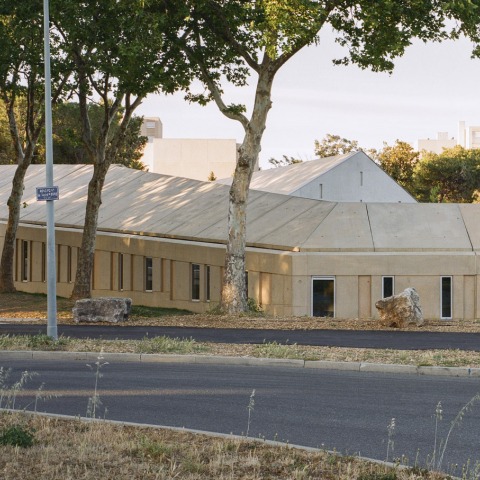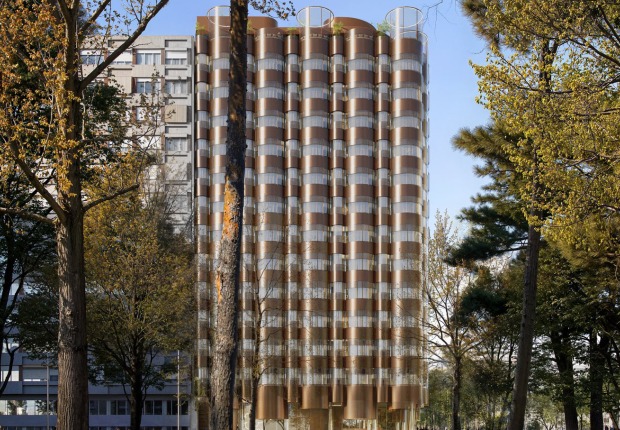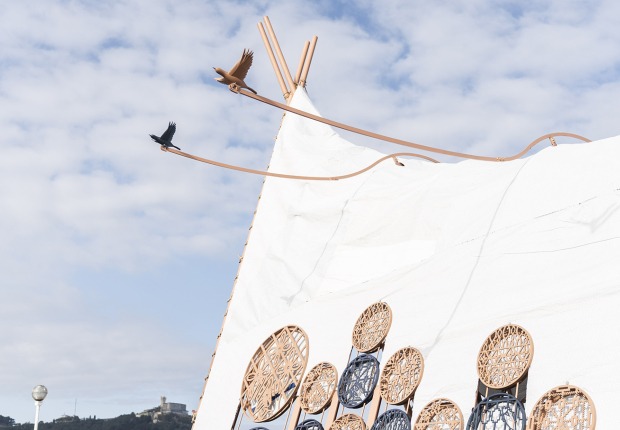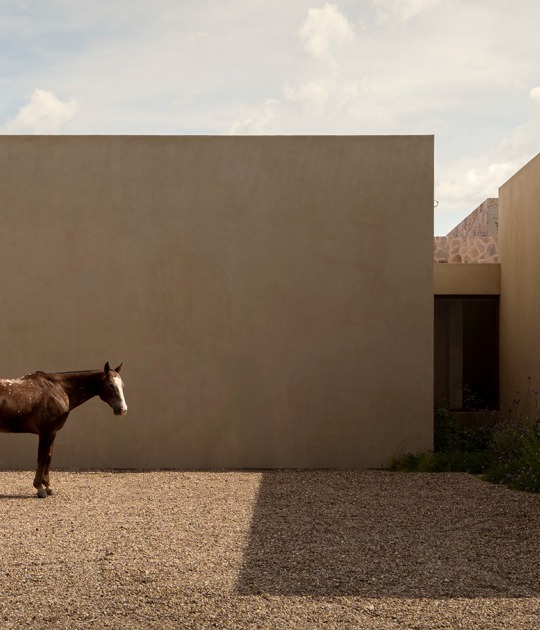The roof is another facade thanks to the use of sandblasted concrete, which makes it easier to unify different planes into a whole, in which the composition merges with its volume.
Upon entering, the classrooms show a generous height and are completely open to the playgrounds. The project is characterized by a double structure, mineral and thick on the city side on the outside and lighter and scalable metallic on the inside on the patio side.
The result is a hybrid building that offers a strong contrast based on an opening to the interior landscape, composed of playgrounds, learning gardens and relaxation areas.
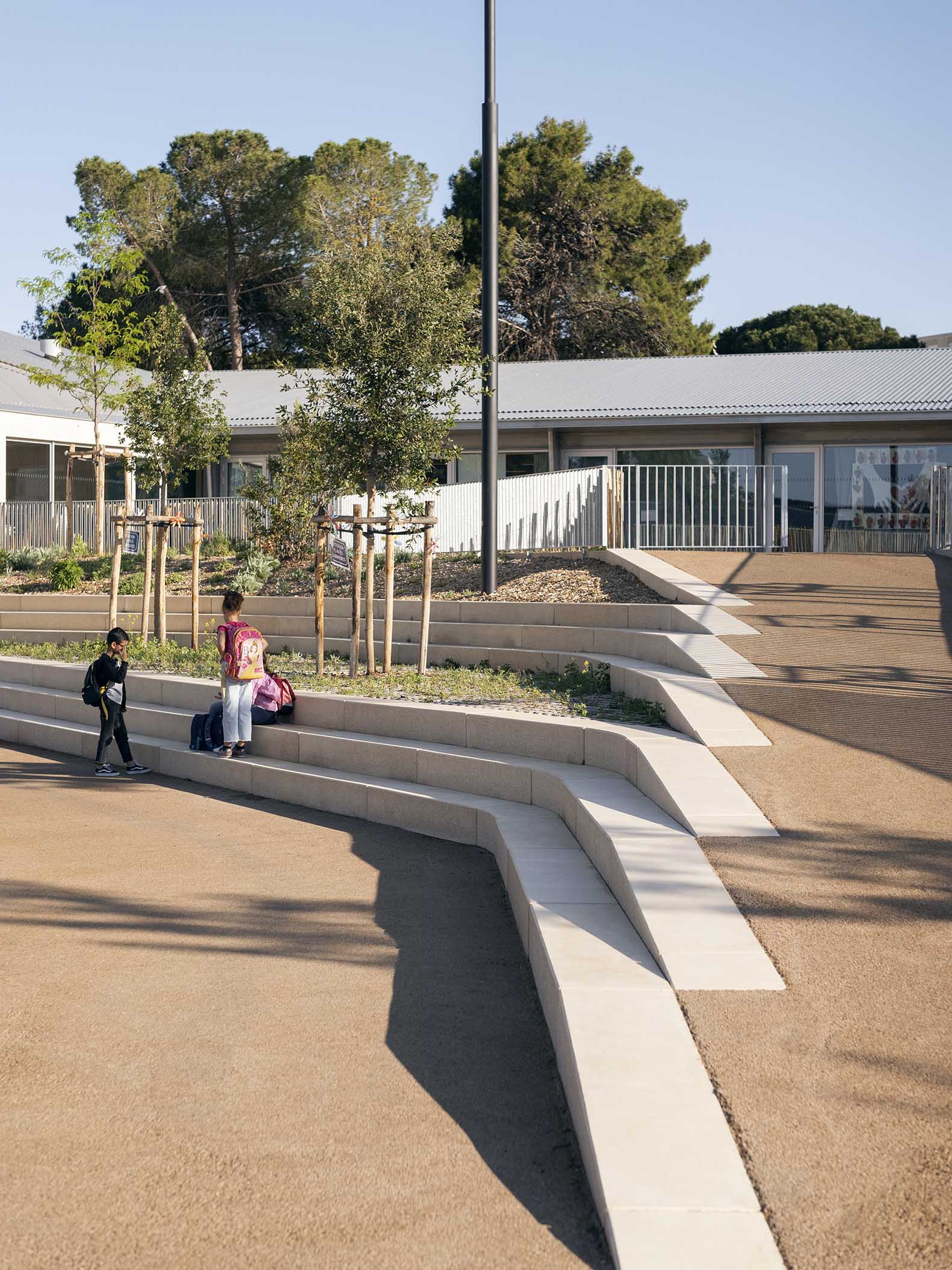
School group Samuel Paty by Ateliers O-S Architectes. Photograph by Cyrille Weiner.
Project description by o-s architectes
Since 2004, the Devèze district has been transforming. Its decongestion allows it to take on a new, more urban and diverse appearance. The large complexes, typical of the 1970s, are replaced by small multi-family buildings or individual houses or by public facilities: a town hall annexe, a community centre, a tree-lined promenade and its grounds dedicated to a range of sports, etc. The Samuel Paty School is part of this renewal.
Since January 2023, the students of the former Ecole des Oliviers have moved to the premises of the new digital and bilingual school located on the neighbouring plot. The building is organised as a large enclosure around its two courtyards, to protect it from the strong wind and the noise of the boulevard, while the buildings that house the other programmes are treated as a juxtaposition of simple volumes separated by the vegetation of the micro-landscapes.
Duality
The Samuel Paty School in Béziers is centred around a strong paradigm that combines massiveness and porosity. Its urban positioning is based on the highlighting of a clean and longitudinal volume that adapts to the site's topography. In the heart of the Devèze district, the primary school is developed only on a single ground floor, to offer a human-level building scale. The roof is therefore a real facade in its own right, in the sense that it is as visible as the elevations. The sanded concrete materiality then makes it possible to unify these different planes into a whole, in which the composition blends with its volume.
By the abstraction of the linearity that develops, the resulting interiority is intended to be faithful. The services are provided according to the curve of the roof and are always in contact with the same mineral materiality, counterbalanced by wooden support elements.
By passing through these first corridors, classrooms develop at a generous height that is fully open to the playgrounds. Thus, the interior life is translated into a lightness and porosity specific to the reception and supervision of children. At the top of the large metal gantries, the inner part of the primary school is sequenced. The glazed frames are positioned for filling according to this structural framework and a sheet metal roof covers the learning areas.
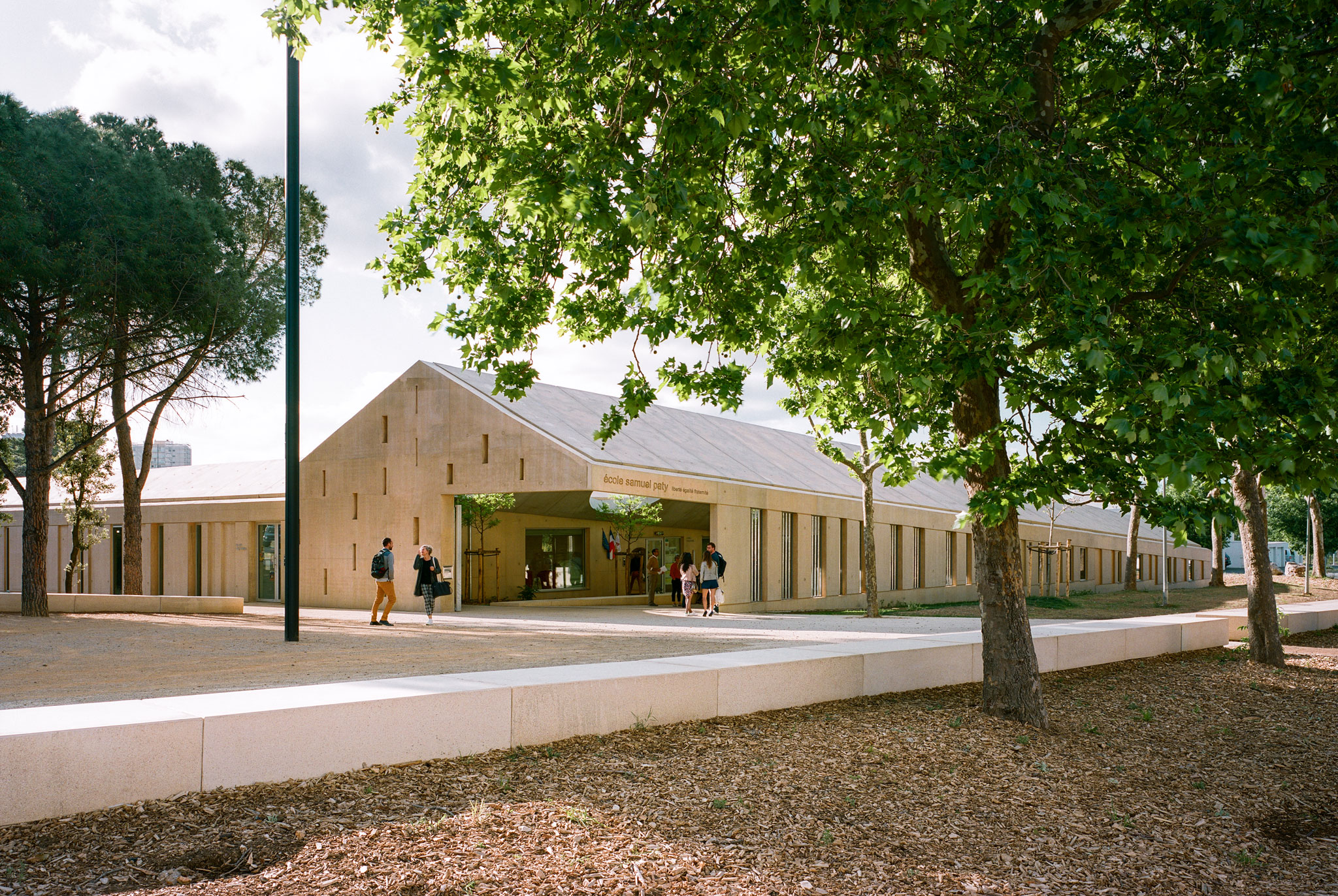
School group Samuel Paty by Ateliers O-S Architectes. Photograph by Cyrille Weiner.
The project is characterised by a double structure, which is mineral and thick on the city side on the outside and lighter and scalable metal on the inside on the courtyard side.
The result is a hybrid building that offers a strong contrast based on an opening to the interior landscape, composed of playgrounds, learning gardens and relaxation areas. Designed as a clean topography, these outdoor spaces meet the building by forming spaces dedicated to terraces, slopes and play, to offer a unique educational space.
From the beginning of the project design, the focus has been on preserving the existing large trees that structure the site. The entrance to the school and its forecourt is located at the junction of the sycamore tree driveway to the west and the pine tree driveway to the north.
This abundance of plant life continues in the school grounds under a large roof pierced by three large, circular skylight openings that shelter the families from the sun and the rain.
Designed entirely in concrete, this space of friendliness and waiting is accompanied by a garden that guides the children from the forecourt to the halls of the school.
On the one hand, the preschool reception, bathed in light, directs the families to the classrooms and offers a wide view of the heart of the school: the playground.
On the other, the primary school reception is planned as a mezzanine on the primary school corridor. Double-height work and play on levels have brought energy to this place of meeting and exchange.
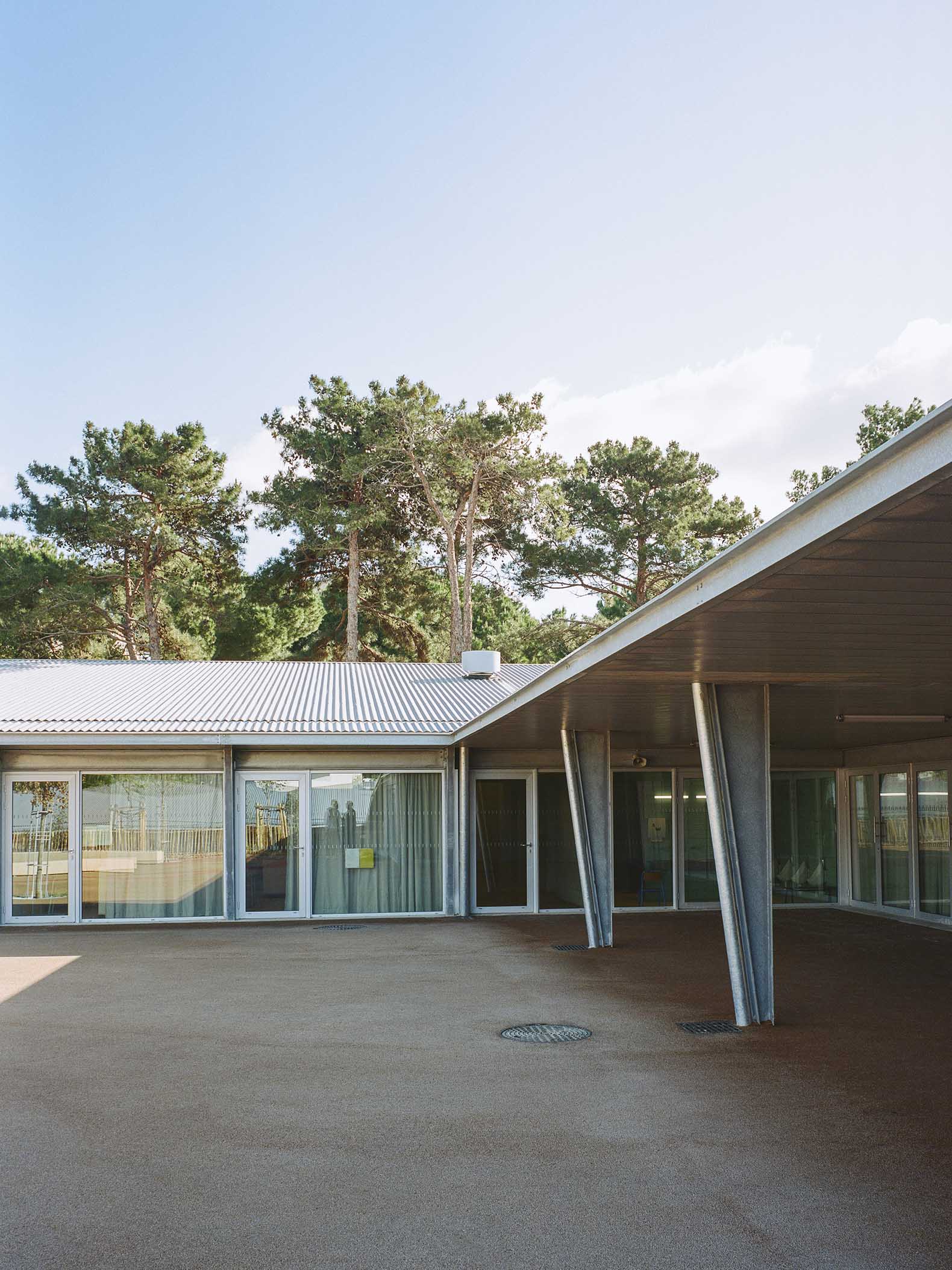
School group Samuel Paty by Ateliers O-S Architectes. Photograph by Cyrille Weiner.
Located directly in connection with the school's two reception halls, the principal's office has a wide field of vision across the internal square. Its position is strategic, to allow contact with families, and also ensure safety within the school complex. Around this office, the administrative centre of the primary school and the RASED (Network of Specialised Support for Students in Difficulty) are organised.
The school's corridor winds around the school as a second protection to the classrooms. It is generous and offers views of both the city and the courtyards across the classrooms.
Considered external but sheltered, this space of distribution and exchange has a non-insulated external concrete facade that leaves the tinted concrete of the facades visible on both sides.
All the acoustic and thermal insulation and the network paths are located in a second interior facade located between the classroom and the corridors.
All the classrooms have been designed in direct connection with the playgrounds. The facade of the classrooms can be opened thanks to French window style openings and allows an interior/exterior continuity that is both visual and physical: the courtyard is an extension of the classroom.
At the gap between the higher level and the lower level, the multi-purpose room encloses the school grounds. Its central position, accessible from the two courtyards, is on the same level as the preschool, to promote the movement of the little ones. Open to the preschool playground and the educational garden, the room is bathed in light.
Its direct entries to the playgrounds will allow for the activities of the classroom to be extended to the outside.
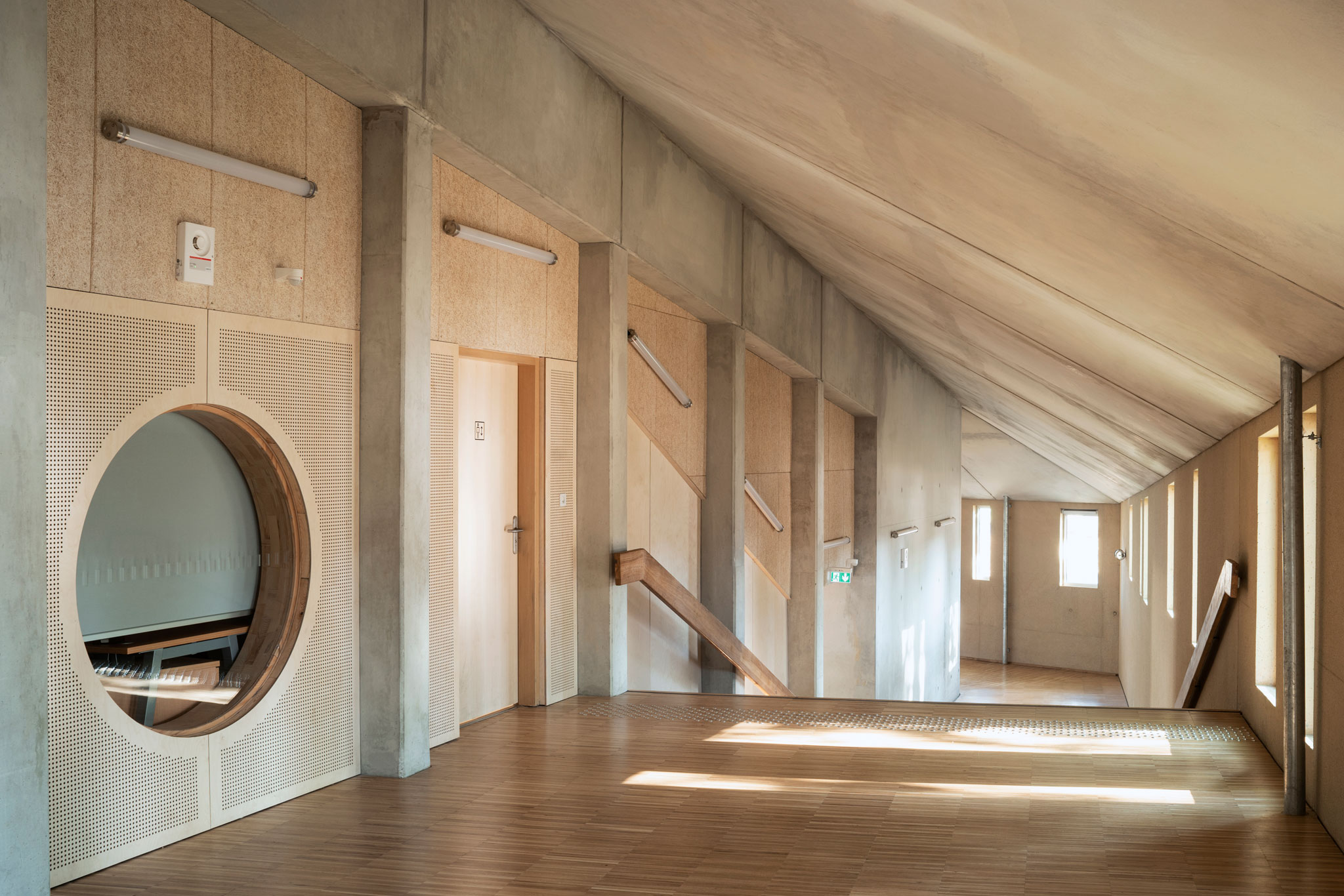
School group Samuel Paty by Ateliers O-S Architectes. Photograph by Cyrille Weiner.
The rationale of the plan promotes a clear and easy organisation for all children and staff. The generous and bright corridor is not heated and not insulated; like an internal street, it runs along the wall of the school for better distancing from the programmes dedicated to children and the town.
Juxtaposed with the school building, all the common areas (library and canteen) are accessible through a shared outdoor space consisting of an educational garden.
This building, autonomous in terms of its volume, is easily accessible from the school, but retains a strategically isolated position in the project:
- favourable to calmness and concentration in the library.
- favourable for deliveries to the canteen and the kitchen due to its direct link to a delivery area at the back of the building.
A car park for the staff is shared with the last two buildings, whose programmes are independent of the school.
On one level and independent of the rest of the school, the building of the medical school is autonomous, but dialogues with the volume of the school with its double slope roof and with its materiality in tinted concrete and metal rooftop.
Located on the edge of the plot, its northern entrance on the Promenade Nelson Mandela makes it possible to boost this pedestrian route and promotes the proximity of the medical school centre with the parking area for the minibus.
All the spaces accessible to the public overlook a planted patio. The light, privacy and autonomy of each office are preserved and access to the rest of the programme is better controlled.
The part reserved for staff is separated from the part that is open to the public. It has a second entrance to the landscaped car park and opens to a small relaxation garden.
Located at the eastern end of the plot, the academy's inspection offices extend the dynamics of the Allée Rosa Parks. Its volume dialogues with the alignment of the existing buildings, taking up the style of the other buildings of the project.
It is entered from "La Placette" of the Allée Rosa Parks and through the use of a half-level feature, a secondary entrance to the landscaped car park is possible.
It is the project's only two-storey building. The reception, the secretaries' offices and the meeting room are located on the ground floor; all the inspectors' offices and the tea room are located upstairs.
